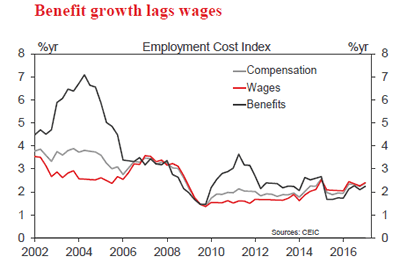Week beginning 24 July 2017
- RBA’s neutral is too high; minutes do not signal a tightening bias.
- RBA: Governor Philip Lowe speaks.
- Australia: Q2 CPI, import/export price indices.
- NZ: trade balance.
- UK: Q2 GDP advance.
- FOMC: July policy decision.
- US: Q2 GDP advance, employment cost index.
- Markit flash PMIs.
- Key economic & financial forecasts.
RBA’s neutral is too high; minutes do not signal a tightening bias
Interest rate markets have reacted marginally to the Reserve Bank’s minutes of its July Board meeting. Despite the Bank setting out a 200 basis point profile for the required move back to neutral, markets priced the "target" rate at August next year up from 1.73%, before the release of the minutes, to 1.84% (close of business) with May now priced at 1.74% compared to 1.64%.
Without doubt the most important result from the minutes of the monetary policy meeting of the RBA Board was to finally nominate the Bank’s estimate of the "new neutral real interest rate for Australia". In other countries it has been recognised for some time that the neutral rate has fallen particularly since the global financial crisis in 2007.
Prior to that, it had generally been accepted that the neutral nominal cash rate for Australia was around 5%. In those pre GFC days, various Bank speakers would refer to "average" being around 5%. This was a curious approach given that, for Australia, the effective interest rate is the mortgage rate so the "average" cash rate had limited significance given that the mortgage margin had been quite unstable.
The minutes highlight that the Bank now believes that the neutral nominal cash rate is around 3.5% indicating a neutral real rate of 1% on the basis that medium term inflation expectations are around 2.5%. Consequently any move back to neutral would involve around 200 basis points in tightening.
Note that the analysis refers to the "neutral nominal cash rate". So, for instance, the increases in mortgage rates that we have recently seen (average of 0.28% across the whole book including 0.76% for interest-only investors) would not be taken into account as part of the 200 basis points in tightening. If the mortgage rate increased by a further 200bps, the evidence of 2011 suggests that house prices would likely fall, as they did under weight of the 200 basis point increase in the mortgage rate in 2011.
That increase coincided with "only" a 175 basis point increase in the cash rate. In short, the evidence of 2011 showed that a 175 basis point increase in the cash rate produced a marked fall in house prices. That would hardly qualify as a neutral stance – falling house prices could be reasonably associated with a wealth and financial stability shock that would push an economy off any stable equilibrium.
Arguably, the discussion around the neutral rate can be interpreted as laying the foundation for a tightening cycle. However with uncertainty around wages and inflation; the consumer; and, of course, the labour market and housing it would be inappropriate to over interpret this signal.
Other central banks have assessed "real neutral". The Federal Reserve believes near term neutral real is "zero" with medium term neutral being 1% real – same as the RBA’s assessment.
Clearly the Bank would accept that "finding" neutral would be an aspect of the policy challenge. As Chairman Greenspan used to note," you will know neutral when you are there." Or Chair Yellen who notes that moves are "data dependent".
The minutes themselves emphasised uncertainty, particularly around the labour and housing markets.
The commentary around the labour market was definitely more confident and the Employment Report for June, that was released two days after the minutes, was also encouraging. Not only do the minutes refer to "employment growth had been strong in May for the third consecutive month" but it is also noted that "forward looking indicators of labour demand … had remained positive and generally consistent with the patterns of employment across states and industries". This commentary suggests that the Board is reasonably comfortable that the recent upswing in employment can be sustained. The only note of caution around the recent developments is that "the underemployment rate … had remained elevated".
We are aware that subdued wages growth is a significant concern for the Bank. That remains a consideration. However, the minutes did point out that the recent Fair Work Commission decision to increase award wages and the national minimum wage by 3.3% (affecting around 40% of workers) was markedly higher than the 2.4% awarded in 2016.
Commentary around the housing market continued to note that conditions vary across the country, although the "auction clearance rates in Sydney and Melbourne had softened recently suggesting that conditions in these markets had eased somewhat". It was also noted that the impact of the prudential supervision measures were yet to have their full effect.
At the time of the board meeting, the Australian Dollar was trading at around USD 0.76. Not surprisingly, the minutes therefore retain the standard terminology "an appreciating exchange rate would complicate this adjustment". With the currency now at USD 0.79, the Board is likely to be more concerned about its impact on the rebalancing process.
The Bank’s thinking about the AUD is measured. The increase in the AUD from USD0.76 to USD0.79 (4%) has been partly due to USD weakness. But the trade weighted Index has also appreciated from 65.1 to 67.3 (3.4%) so the majority of the boost has been commodity prices and this perceived hawkish stance from the RBA. The Bank will regret the degree to which the latter is a factor while also eschewing higher commodity prices since the major beneficiaries (the mining companies) are not expected to boost investment or employment in the wake of higher expected profits. In effect there is no offset to the reduced competitiveness stemming from a higher AUD.
The higher AUD will impact the perceived risks around the Bank’s inflation and growth forecasts.
As the minutes point out, financial market pricing for RBA policy has "shifted to indicate some probability of an increase in the cash rate by mid-2018". The most important development behind this outlook is the improved conditions in the labour market.
The implications for policy from the housing market are less clear. The macroprudential policies have already resulted in higher mortgage rates, and as noted in the minutes, pressures in the housing market appear to be easing.
Recall that the Bank’s current forecasts for GDP growth in 2018 are an above trend 3.25%. That contrasts with our own forecast of only 2.5%. Our forecasts envisage ongoing caution from the consumer; no significant recovery in non-mining investment and detraction in growth from housing construction.
Furthermore, the growth profile which we described is unlikely to be consistent with sustained improvement in the labour market. The short-term outlook for employment growth is positive. However we expect that, around year end, the unemployment rate will turn and will edge back towards 6% over the course of 2018.
Despite a more confident Bank and its decision to set out its new so-called "neutral target", our forecasts remain consistent with the cash rate staying on hold throughout 2017 and 2018.
Furthermore the evidence, particularly around the housing market, suggests that "neutral" is closer than 200 basis points away.
Data wrap
Jun Westpac-MI Leading Index
- The six month annualised growth rate in the Westpac- Melbourne Institute Leading Index, which indicates the likely pace of economic activity relative to trend three to nine months into the future, fell sharply from 0.51% in May to -0.76% in June.
- The index is pointing to a slowdown in momentum in Australia’s growth profile with the first below trend reading since July 2016. The deterioration mainly reflects international factors including a sharp turnaround in Australia’s commodity prices in Australian dollar terms.
- The Leading Index growth rate has slowed from 1.61% above trend in January to 0.76% below trend in June (a deterioration of 2.37ppts). Two components account for all of the reversal: commodity prices and the yield spread. After surging 42% over the second half of 2016, Australia’s commodity prices have fallen 17% over the first half of 2017 in AUD terms. The swing has seen this component alone go from adding 1.26ppts to the Leading index growth rate in January to subtracting 0.71pts off in June, a reversal worth 1.97ppts. Some of this reflects the unwinding of temporary policy and weatherrelated spikes in coal prices. However, a strong rally in iron ore prices through much of last year also moved into reverse from early 2017 through mid-June.
Jun labour force
- Total employment rose 14k compared the market’s forecast for 15k. In the month unemployment was flat a 5.6% (May was revised up from 5.5%) as the participation rate nudged up 0.1ppt driving a rise in the labour force; at two decimal places the unemployment rate was 5.65%.
- The Australian labour market went through a soft patch in 2016, particularly from August to November, but there has been a solid uplift as we moved through 2017. The annual pace accelerated from 0.9%yr in Feb to 2.0%yr in May holding that pace in June. In the year to Feb total employment grew 106.9k which has since lifted to 240k in the year to June. The 14k gain in June represents an average of 33.7k per month.
- Full-time employment surged 62.0k in June following on from a 53.4k gain in May. In the year full-time employment gained 175.4k/2.1yr. Part-time employment fell 48k following a -15.4k in May. In the year to June, part-time employment lifted 64.8k running at a slower pace than full-time employment for the first time since Mar 2015.
- By state, there were solid gains in NSW (+3.6k), Vic (+3.7k), SA (4.6k) and WA (6.9k). The only mainland state to report a decline was Qld (-1.0k). Unemployment was flat in NSW (4.8%), it fell in Vic (5.9% from 6.0%) and SA (6.6% from 6.9%) while the unemployment rate lifted in Qld (6.5% from 6.1%) and WA (5.6% from 5.5%).
- A further sign of the overall strength of this report was the 0.5% lift in hours worked following the 1.7%mth jump in May. The annual pace for total hours worked lifted to 3.3%yr which is the fastest pace seen since Dec 2015.
New Zealand: week ahead & data wrap
Old school
This week’s inflation report confirmed that prices in New Zealand were subdued in the June quarter, and in fact even softer than expected. While technological change has played some part, the recent weakness in inflation seems to be largely for old-fashioned reasons.
Consumer prices overall were flat in the June quarter, following a surprisingly large 1% increase in the March quarter. That saw the annual inflation rate slow from 2.2% to 1.7%. Both of the last two quarters were affected by what we expect to be temporary factors, so these numbers probably overstate the degree to which inflation has swung around lately. But a broad range of measures of underlying inflation also point to a slowdown in the annual rate.
New Zealand is far from alone in that regard. Many of our trading partners – most of whom report their inflation figures monthly, rather than quarterly – have already seen a pullback in both headline and underlying inflation measures in recent months, after a strong pickup in the early part of this year. The common thread is oil prices, which rose sharply between early 2016 and early 2017 but have dropped back a bit since then.
As for New Zealand specifically, we can break the trends in inflation down to two broad themes. First, most of the slowdown in the inflation rate over the June quarter was in the tradables component. That includes the drop in fuel prices, but there were also some big price drops for import-heavy items such as home furnishings and electronics.
The electronics components of the CPI – such as TVs, computers and smartphones – need to be read with caution, as the prices are heavily quality-adjusted to take account of improving technology. So while there was a particularly large drop in these prices in the June quarter, they’ve been falling rapidly for many years now. And their deflationary influence is no greater now than it was in the 2000s, when inflation overall was persistently testing the top end of the Reserve Bank’s target.
The more significant factor that has weighed on tradables inflation was the strong rise in the New Zealand dollar over 2016 – up around 12% in trade-weighted terms. Exchange rate movements flow through to the retail prices of imported goods with a typical lag of two to three quarters, reflecting importers’ stock turnover rates and/or exchange rate hedges. The lag isn’t precise – there was less exchange rate passthrough than we expected in the March quarter, but more than expected in the June quarter. But if we take the two quarters together, the strength of the relationship between the NZD and tradables inflation seems to be much the same as it ever was.
The second theme is that non-tradables inflation, while up from its lows, is still running substantially below where it was in the years before the Global Financial Crisis. This group includes government charges and other non-market prices, which on balance have actually been less of an inflationary force in recent times.
But for the most part, non-tradables inflation reflects the strength of domestic demand and the extent of domestic capacity constraints. And here, the reason for low inflation is simple: the local economy just isn’t growing fast enough to see it overheat. Strong population growth means that New Zealand’s GDP is growing faster than many of our peers, but in per capita growth terms we’re distinctly in the middle of the pack. The unemployment rate has been declining, and at around 5% it’s arguably no longer in disinflationary territory, but it’s not in what most economists would consider to be in inflationary territory either.
The notable exception to the domestic inflation story is in housing. Prices for newly built homes (excluding the land value) rose 6.4% in the year to June; in Auckland they rose by 8.1%. But we note that this component of the CPI has been rising strongly for several years, with no sign of these price pressures spilling over into other areas. Rising prices and the slow supply response seem to be very much a product of the structure of the homebuilding industry, which is understandably coming in for increased scrutiny.
For the Reserve Bank, the policy prescription remains the same. The economy needs to be allowed to continue to grow and gradually use up its spare capacity, in order for inflation to settle around the 2% target midpoint on a sustained basis. And that means keeping interest rates at low levels for an extended period.
The June quarter CPI is the last major piece of data before the RBNZ starts to prepare its August Monetary Policy Statement. (The June quarter labour market figures are released in early August, but not in time to make it into their forecasting process.) Recent developments have generally been of the soft side: inflation was lower than forecast, the New Zealand dollar has strengthened, and the housing market is cooling down much faster than the RBNZ expected.
If the RBNZ was "firmly neutral" in its last review, it is hardly going to be mulling the timing of interest rate hikes this time around. We think that the market is off-base in pricing in an OCR hike for next year, even if the timing has been pushed out from June to August since the CPI figures. In contrast, we don’t expect an OCR hike before 2019, and that sort of horizon is too far out to be specific about the timing.
Data previews
Aus Q2 Consumer Price Index
Jul 26 Last: 0.5%, WBC f/c: 0.6%
Mkt f/c: 0.4%, Range: 0.2% to 0.8%
- The Q1 CPI printed 0.5% for an annual rate of 2.1%yr compared to 1.5%yr in Q4, 1.3%yr in Q3 and 1.0%yr in Q2. The June quarter 2016 was the lowest rate of annual inflation since June 1999.
- The core measures, which are seasonally adjusted and exclude extreme moves, rose 0.4% on average compared to the market’s expectation of 0.5% rise. The annual pace of the average of the core measures is now 1.8%yr from 1.5%yr in Q4 and Q3.
- In the June quarter, a large Debbie boost to fruit plus a recovery in dwellings are offset by falling auto fuel. Westpac’s forecast for the headline CPI is 0.6%qtr lifting the annual pace to 2.4%yr from 2.1%yr. Core inflation is forecast to print 0.5%qtr (0.54% at two decimal places) holding the annual rate flat at 1.8%yr.
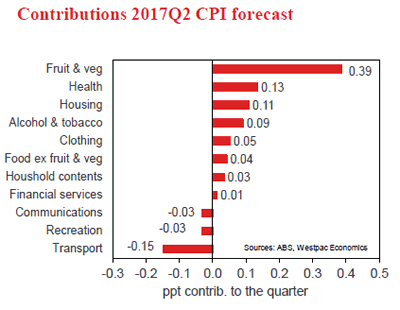
Aus Q2 import price index
Jul 27, Last: 1.2%, WBC f/c: 0.7%
Mkt f/c: 0.7%, Range: -1.0% to 2.0%
- Import goods prices were little changed over the past year, with a Q1 result of +1.2%qtr, -0.6%yr.
- For the June quarter, the price of imported goods is expected to edge higher, increasing by 0.7%, reflecting the impact of the weaker currency. That would have import prices 1% above the level of a year ago.
- The Australian dollar weakened during the June quarter, declining by 2.2% on a TWI basis, reversing the gain in the previous three months. Over the past year, the dollar is 3% higher on a TWI basis.
- Global energy prices fell in the June quarter, declining by around 5%. Lower fuel prices partially offset the impact on import prices of the weaker dollar.
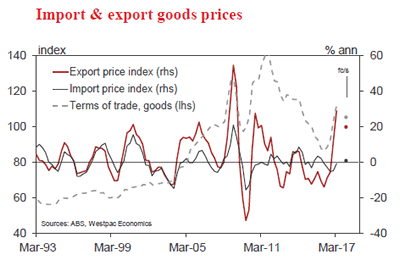
Aus Q2 export price index
Jul 27, Last: 9.4%, WBC f/c: -5.5%
Mkt f/c: -5.5%, Range: -12.0% to -2.9%
- Export prices increased sharply over the past year, rebounding as commodity prices bounced off the lows prevailing early in 2016.
- In Q1, the export price index increased by 9.4%qtr, 29.1%yr.
- However, the tide turned in the June quarter. Commodity prices eased back in the period, falling by about 8% in AUD terms, driving a fall in export prices.
- For Q2, the export price index is expected to decline by 5.5%. Annual growth moderates to 20%.
- The terms of trade for goods, on these estimates, fell by 6.2% in the quarter, trimming annual growth from 30% to 18.5%.
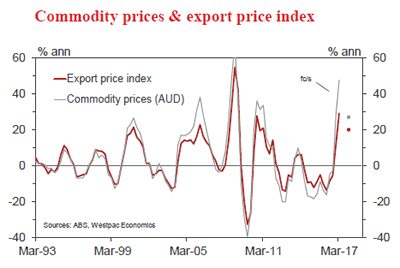
US FOMC July meeting
Jul 26, Last: 1.125%, WBC 1.125%
- In their June meeting communications, the FOMC remained resolutely positive on the outlook for the economy. This was principally owing to the strength of the labour market and a belief that, inevitably, this would translate into stronger wages growth and consumption. Their view of business investment was also constructive.
- A degree of unease however emerged in the minutes, with fiscal policy shifting from a solely positive risk to an either or proposition; the potential negative impact on investment of fiscal impasse was also noted. Since then, some members of the FOMC have also questioned the potential impact of balance sheet normalisation on the Fed Funds Rate path.
- Absent Q&A and forecasts, the July meeting offers limited scope to provide detailed guidance. But you can expect the statement to contain a positive view to keep the FOMC’s options open, particularly given the market’s sombre view.
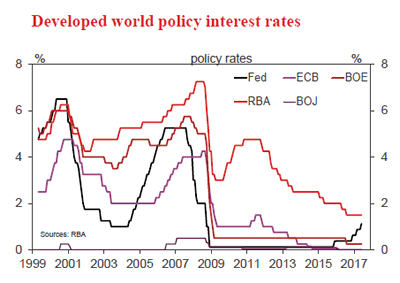
US Q2 GDP
Jul 28, Last: 1.4%, WBC 2.5% (annualised)
- Q1’s 1.4% annualised outcome was a disappointment for a number of reasons, but most notably because of the weakness evident in consumption. To an extent this was due to unseasonal weather which limited demand for services – two-thirds of total consumption.
- However, durables and non-durables demand also experienced a material deterioration in Q1. Come Q2, the demand pulse for these categories is again likely to underwhelm. Partial data also suggests services will struggle to accelerate materially. Given confidence and jobs growth, spending should be much stronger.
- Business investment rebounded in Q1, but Q2 will see slower growth; the public sector’s contribution will also be negligible. All told, a 2.5% gain is most likely. Risks are skewed to the downside and centred on the consumer.
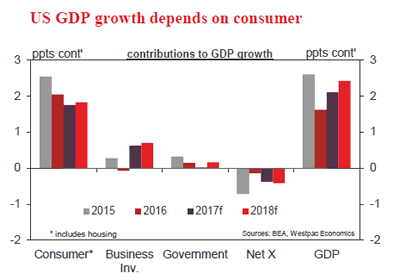
US Q2 Employment Cost Index
Jul 28, Last: 0.8%, WBC 0.6%
- Q1 finally saw a stronger wage outcome, total compensation rising 0.8% in the three months to March. This was driven by a 0.8% gain for wages, although benefits also rose 0.7%. Compensation is up 2.4%yr; wages 2.5%yr.
- The strength shown in the labour market should see wages growth accelerate. However, the pass through has been underwhelming to date, hence further progress is likely to be slow going.
- It is important to note that an eye also needs to be kept on benefits growth, with private-sector employers clearly using this component of consumption to offset demands for stronger wages from workers.
- Given the above, we look for a 0.6% rise for total compensation, though the wage gain could be stronger. That will keep the annual rate for compensation unchanged.
